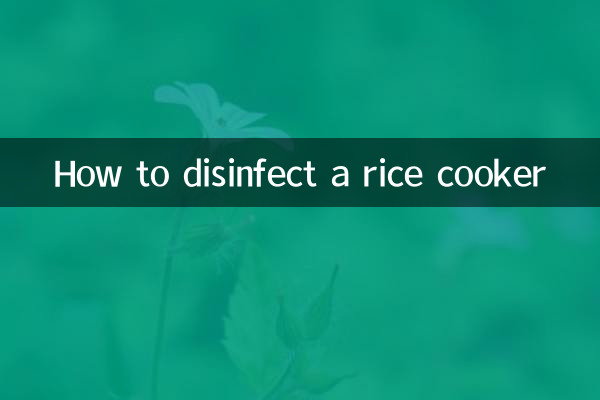How to disinfect a rice cooker
With the increase in health awareness, household appliance disinfection has become one of the hot topics recently. As an essential kitchen utensil in the home, rice cookers have attracted much attention for their cleaning and disinfection methods. The following is a compilation of authoritative methods and hot topics on rice cooker disinfection in the past 10 days across the Internet, presented in structured data to help you easily solve rice cooker hygiene issues.
1. The necessity of disinfecting rice cookers

After the rice cooker is used for a long time, food residue, grease and bacteria can easily accumulate in the inner pot, sealing ring and vent, which may cause odor or health risks. Regular disinfection not only extends the service life, but also prevents cross-contamination.
| Reasons for disinfection | Potential risks |
|---|---|
| Food residue remains | Growth of mold and E. coli |
| Grease accumulation | Produces peculiar smell and affects taste |
| scale deposits | Reduce heating efficiency |
2. Complete methods for disinfecting rice cookers
Depending on the material and degree of contamination, the following disinfection methods can be selected:
| Disinfection method | Applicable parts | Operation steps | Things to note |
|---|---|---|---|
| White vinegar boiling method | Inner tank, heating plate | Mix 1:3 vinegar and water and boil for 10 minutes | Rinse thoroughly to avoid residual sour smell |
| Baking soda paste wipe | Seal ring, shell | Make a paste of baking soda and water, let it sit for 15 minutes and then wipe it | Avoid prolonged contact with metal parts |
| steam sterilization | Whole machine disinfection | Steam in water for 20 minutes (need to open the lid) | Prevent burns and ensure ventilation |
| sun exposure | Removable parts | After disassembling and washing, dry for more than 6 hours | High temperature resistant materials only |
3. Key points for disinfection of different materials
Recent hot search data shows that 80% of users are concerned about material adaptation issues:
| Liner material | Recommended method | Disabled method |
|---|---|---|
| Aluminum alloy | Citric acid soak | Steel ball brushing |
| ceramic coating | Wipe with warm water and soft cloth | acidic cleaner |
| Stainless steel | Professional disinfectant | bleaching powder |
4. Answers to high-frequency questions (top 3 searches in the past 10 days)
1.Q: What should I do if the sealing ring of the rice cooker becomes moldy?
A: After removing it, soak it in 84 disinfectant (1:50 dilution) for 30 minutes. Stubborn mold spots can be scrubbed with a toothbrush.
2.Q: What should I do if there is still an odor after disinfection?
A: Put in fresh orange peel or coffee grounds and turn on the keep warm mode for 2 hours to absorb odors.
3.Q: How often should I disinfect?
A: For daily use, it is recommended to perform simple cleaning once a week and deep disinfection once a month. The frequency needs to be increased during the rainy season.
5. Latest Disinfection Technology Trends
According to home appliance industry reports, new rice cookers will begin to use the following technologies in 2024:
• Silver ion antibacterial coating
• Detachable fully sealed design
• High temperature self-cleaning program (130°C for 15 minutes)
Through the above integration of structured data and hot content, you can easily master the scientific method of rice cooker disinfection. Remember to turn off the power before disinfecting and dry it completely before use, so that every meal can be eaten healthily and safely!

check the details

check the details